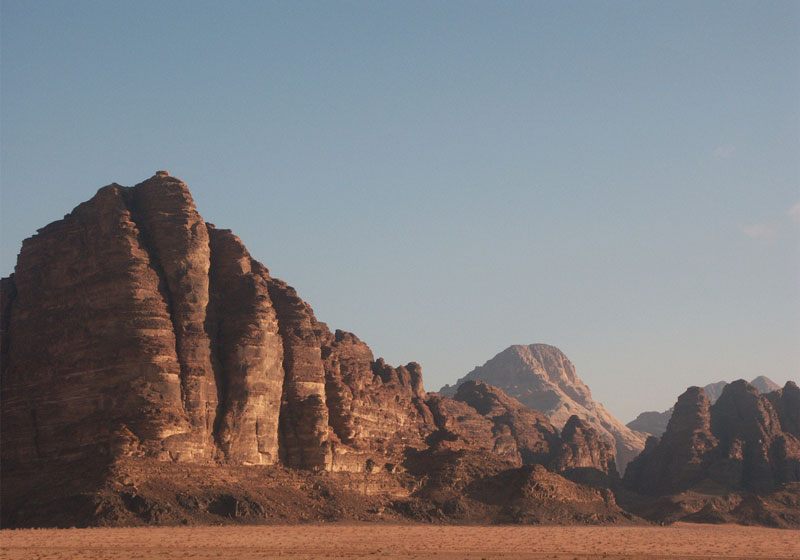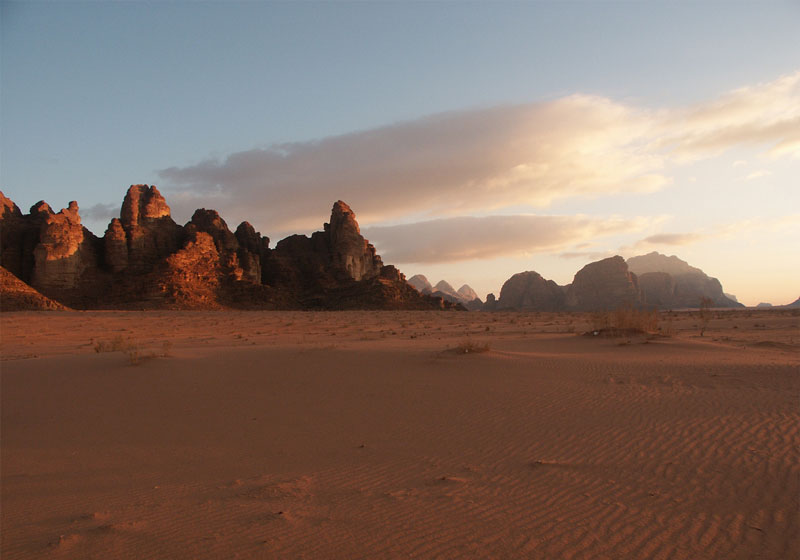Walking on a Vertical Landscape
It is important to experience Wadi Rum one aspect at a time in order to fully discover and enjoy this wide and unique landscape. This is a destination of varied attractions (general tourist attractions, mountain climbing, birds and wild plants, star watching, archeology, Bedouin culture… etc.) Rum can demand from certain types of visitors a lasting relationship culminating to a degree of devotion, as it lures its lovers to return time and again. Rum can enrich and educate some of us for a lifetime.
Here, the Rum destination would be explored through the water springs and the small, tranquil, special spots they create. Spots of little “hanging gardens” in the middle of this vast, dry, eerie, and peculiar landscape.

Arriving at Wadi Rum is like coming from an open outdoor space to an indoor space of vast dimensions. This feeling acquires its full strength when you see the Rum village from a distance. This grand space is the largest and most defined corridor or gallery, with vertical walls and smaller side corridors. Rum can also be compared to a city with monolithic window-less buildings. The Main corridors running north-south, with one major corridor, Khor Ajram, running east-west, reveal a recognisable grid that responds to subterranean faults. Where Khor Ajram meets Wadi Rum, Jabal Khaz'ali stands as a central altar in a landscape that appears like a huge ruined temple, with maroon walls and a deep-blue ceiling.
What is surprising, and often deceiving, is that the altitude of the “bottom” of Wadi Rum is 900 metres above sea level (1,000m high at the base of Khaz’ali Mountain). Descending from Ras Al Naqab to Wadi Rum is not like descending from Amman to the Jordan Valley. On the platform that appears like a "Wadi” or valley, Jabal Rum, the mountain to the west of the Rum Village, is a unique monument. It is a chunk of sandstone, 700 meter thick, that sits on a pedestal of granite about 40 meter high to reach a total height of 1,754 metres above sea level; Jordan’s highest summit.
It would be more accurate, geologically speaking, to think of Wadi Rum as tableland, with sandstone pillars standing on it, rather than a valley. The visible line of contact between granite and sandstone can organize our understanding of this natural monument. Below this line, granite, with its massive boulders, is exposed to us as a profile that looks like the side of a ruined pyramid, with an overall slope close to 45 degrees. Above this contact line, sandstone stands mainly vertical, borrowing from architecture many elements such as domes, cantilevered monolithic shelves looking like balconies, and arches that, in time, form complete bridges. Sandstone behaves like an architect, one who is flexible, detail-oriented, and has a soft spot for ornaments.

This contact line is also the boundary between rocks of opposite origins. Granite is igneous (was molten before becoming rock), it is Jordan’s oldest rock, related to the “continental basement” that was formed by the cooling of the earth after its creation some 4.6 billion years ago. Sandstone is sedimentary and has been built up in layers under water some 500 million years ago. From this point where rocks created by fire meet rocks created by water, a line of gentle springs hide within their depth many secrets of this strange land.
There are two main springs on this line: Ain Shallaaleh (closer to the rest house) and Abu 'Aina further to the south. Besides these two springs, all along the contact line of granite-sandstone, water seeps out into light in different amounts. This line is a wonderful walk and easy to explore. It is like a crack in a big clay jar seeping water; a secret that birds and plants learned so well and shared with the Edomites, the Nabateans and the bedouins.
Wild fig trees cling to this line like leeches to their host, their roots run horizontally following the farthermost drop of water. As these trees hang on this lifeline, their root system creates a web of veins adapted to this vertical oasis –they have to master their anchorage in order to survive.
This water line is fed by the massive Jabal Rum, a chunk of sandstone that works like a big sponge sitting on a slab of impermeable granite. Granite, the harder rock, acts like a tray sloping eastward, hence the location of springs on the eastern side of the mountain. The granite of Wadi Rum keeps sloping downward as we move east, and disappears completely underground at the eastern parts of the protected area in the direction of Mudawwara.
Understanding the geology of Wadi Rum can help us enjoy it as an “integrated system”, revealing the fuller story as told by nature with its magnitude, subtleties and art forms.
Wadi Rum is an experience in altering your visual scale; its vertical elevations are so vast that they can re-format your sense of proportion, completely re-setting the visual calibrations between vertical and horizontal. Rum is definitely an experience and possibly a transformation.
Wadi Rum offers basic and safe camping facilities for the family with teenage kids. The “famous” sights can be done in one full day, but for those who like hiking and exploring off-the-beaten-track, two or three days would effectively leave a lasting impact. Wadi Rum is an ideal “exercise destination” for individuals caught-up in the urban fray who want to refresh the body and spirit. Rum is relatively cooler than the eastern desert and its dry clean air is therapeutic and invigorating. A trip can be combined with other destinations – Aqaba, Petra, and less famous spots like Humaima (an Islamic site west of the Highway to Aqaba), Udruh on the way from Petra to Ma'an, the gardens of Ma’an, and, during the winter, the drive from Disi to Mudawwara.